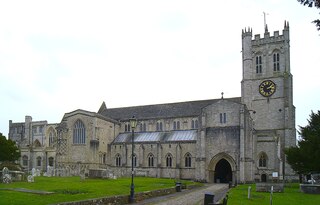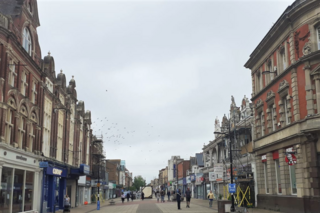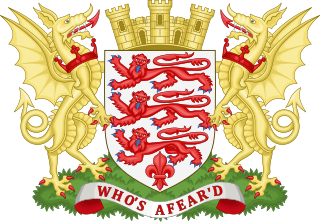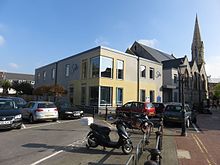
Dorset is a ceremonial county in South West England. It is bordered by Somerset to the north-west, Wiltshire to the north and the north-east, Hampshire to the east, the Isle of Wight across the Solent to the south-east, the English Channel to the south, and Devon to the west. The largest settlement is Bournemouth, and the county town is Dorchester.

Bournemouth is a coastal resort town in the Bournemouth, Christchurch and Poole unitary authority area, in the ceremonial county of Dorset, England. The 2021 census built-up area had a population of 196,455, making it the largest town in Dorset.

Christchurch is a town and civil parish on the south coast of Dorset, England. The parish had a population of 31,372 in 2021. It adjoins Bournemouth to the west, with the New Forest to the east. Part of the historic county of Hampshire, Christchurch was a borough within the administrative county of Dorset from 1974 until 2019, when it became part of the new Bournemouth, Christchurch and Poole unitary authority.

Poole is a coastal town and seaport on the south coast of England in the Bournemouth, Christchurch and Poole unitary authority area in Dorset, England. The town is 21 miles (34 km) east of Dorchester and adjoins Bournemouth to the east. Since 1 April 2019, the local authority is Bournemouth, Christchurch and Poole Council. The town had an estimated population of 151,500 making it the second-largest town in the ceremonial county of Dorset. Together with Bournemouth and Christchurch, the conurbation has a total population of nearly 400,000.

Tower Park is a leisure and retail park, located at Mannings Heath, in Poole, Dorset, England. It was one of the first complexes of its kind in Europe when it opened in 1989.

Boscombe is a suburb of Bournemouth, England. Historically in Hampshire, but today in Dorset, it is located to the east of Bournemouth town centre and west of Southbourne.

Bournemouth University is a public university in Bournemouth, England, with its main campus situated in neighbouring Poole. The university was founded in 1992; however, the origins of its predecessor date back to the early 1900s.

Upton is a town in south-east Dorset, England. Upton is to the east of Holton Heath and Upton Heath, and to the north of the Poole suburb of Hamworthy. It is the second largest town in the Purbeck Hills.

Canford Heath is a suburb, an area of heathland, and an electoral ward in Poole, Dorset. It is known for being the largest heathland in Dorset, and the largest lowland heath in the UK. It is also the name of the housing development built on the heathland in the 1960s, 1970s and 1980s. At the 2021 census the population of the ward was 14,387.

Dorset County Council was the county council of Dorset in England. It was created in 1889 and abolished in 2019. Throughout its existence, the council was based in Dorchester.

St Peter's Church is a Church of England parish church located in the centre of Bournemouth, Dorset, England. It is a Grade I listed building classed as a 'major parish church', and was completed in 1879 to a design by George Edmund Street as the founding mother church of Bournemouth.

The history of Bournemouth and human settlement in the surrounding area goes back for thousands of years. Bournemouth is a coastal town on the island of Great Britain in Dorset, England, United Kingdom.

Poole Hospital is an acute general hospital in Poole, Dorset, England. Built in 1907, it has expanded from a basic 14-bed facility into a 789-bed hospital. It is the trauma centre for east Dorset and provides specialist services such as cancer treatment for the entire county. It is managed by the University Hospitals Dorset NHS Foundation Trust. The hospital was managed by Poole Hospital NHS Foundation Trust until the merger with The Royal Bournemouth and Christchurch Hospitals NHS Foundation Trust on 1 October 2020.
The Carbuncle Cup is an architecture prize, given annually, originally by the magazine Building Design, and since 2024 by The Fence, to "the ugliest building in the United Kingdom completed in the last 12 months". It was intended to be a humorous response to the prestigious Stirling Prize, given by the Royal Institute of British Architects.

Ensbury Park is a mainly residential suburb of Bournemouth, in Dorset, England. It includes the housing estate of Slades Farm and lies within the ward district of Northbourne and Redhill.

Skinner Street United Reformed Church is the oldest church in Poole, Dorset, England. The current building is the only eighteenth century church building in Poole, and is a Grade II* listed building. The church has a grave for Cyril Coles, one of the gunners in the first tank attack in 1916. The church is used as an adult learning centre.

Bournemouth, Christchurch and Poole Council, which styles itself BCP Council, is the local authority for Bournemouth, Christchurch and Poole, a local government district in the ceremonial county of Dorset, England. The council is a unitary authority, being a district council which also performs the functions of a county council. It is independent from Dorset Council, the unitary authority which administers the rest of the county. The district was created on 1 April 2019 by the merger of the areas that were previously administered by the unitary authorities of Bournemouth and Poole, and the non-metropolitan district of Christchurch.

Poole Civic Centre is an Art Deco municipal building in Poole, Dorset. Since 7 October 2019 the building has been a Grade II listed building. Also sometimes known as Poole Town Hall, the civic centre was the headquarters of Poole Borough Council until 2019.

The Bournemouth Blitz was the heavy bombing of Bournemouth, Hampshire, England from 1940 to 1944, by the Nazi German Luftwaffe during the Second World War.



















